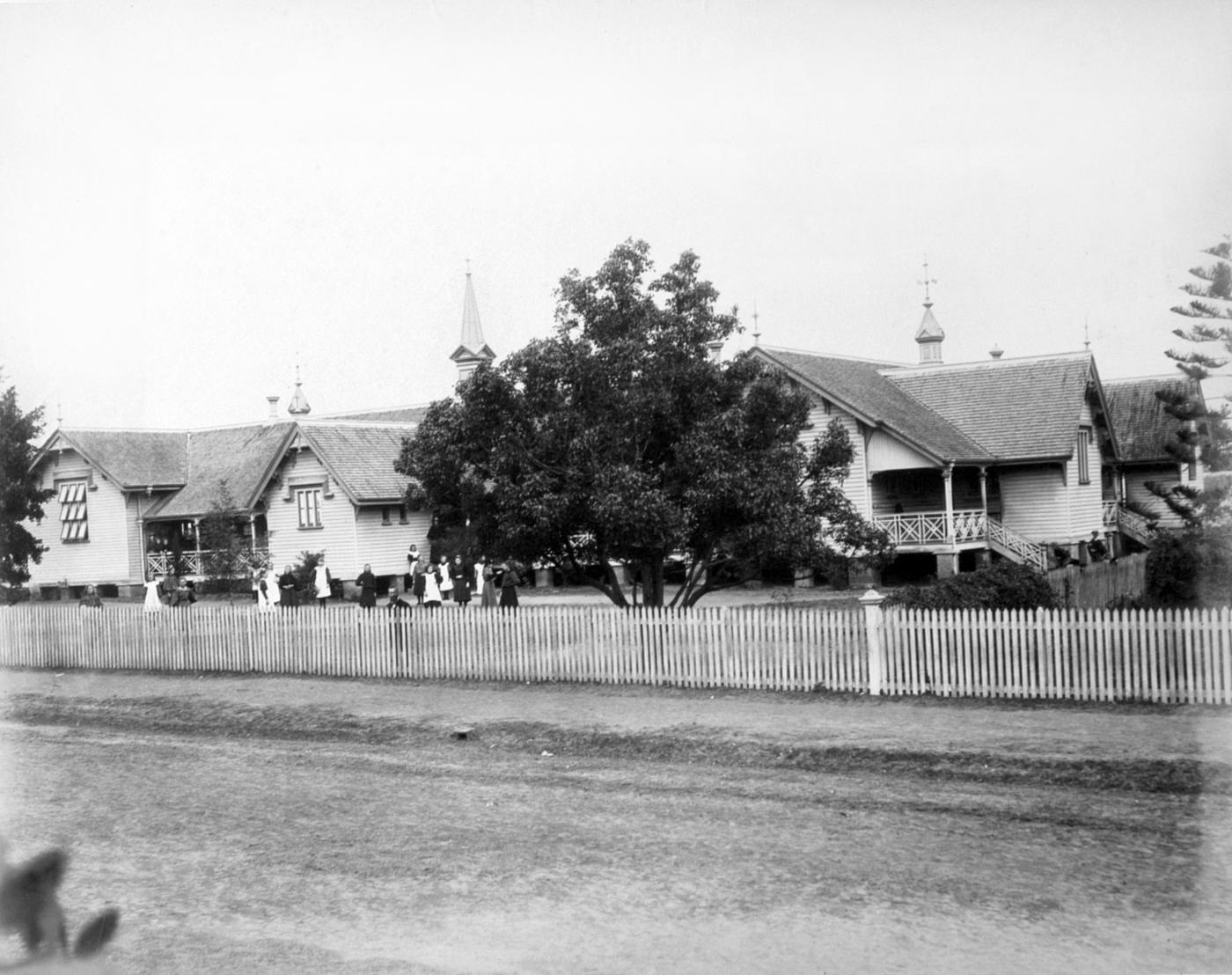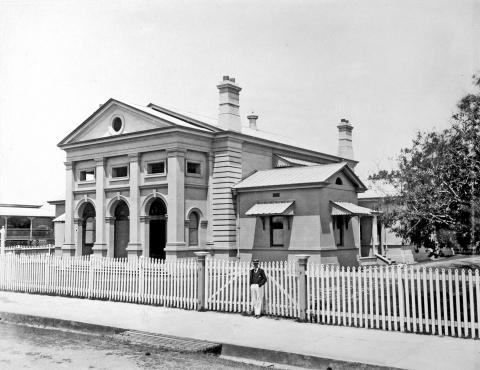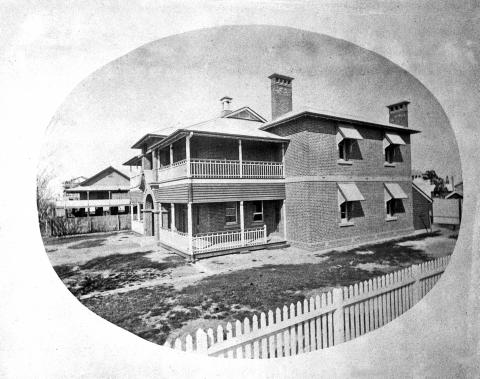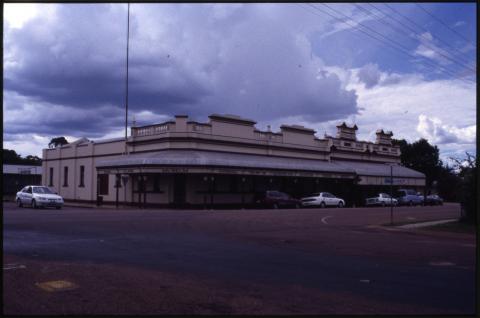
- News of the day
-
Maryborough Chronicle, Wide Bay and Burnett Advertiser, Friday 4 December 1896, page 2
THE ALBERT STATE SCHOOL.
Maryborough has reason to be highly proud of her several State schools and of the Albert school, in particular. That school enjoys not only the enviable distinction of being the largest and best equipped school in Maryborough, or the district, but in Queensland, and ranks probably second to the Normal School, Brisbane, in all respects, if not superior in some. A visit to this school is a pleasure, and an inspection of the methods and means of imparting instruction to the children is most interesting and edifying.
The Albert School stands on a hill to the south-east of Maryborough. The position is retired and eminently suited for its purpose. Beyond, the Mary river forms a crescent enclosing the fertile “Pocket” now largely devoted to sugar-cane. The grounds are surrounded by beautiful camphor laurels and fig-trees. It was opened in July, 1883. Messrs. Harrington and Dunlop with others, interested themselves and gathered the very heavy contributions needed. Mr. Kennedy, now district inspector, took charge. He was followed by Mr. Papi, who also became an inspector. The present teacher is Mr. James, who has had charge for nearly eight years. The number of children on the rolls is 786, giving an average of 658 for the past three months. The district inspectors have always spoken well of the school, the last report states that “the school is in a highly satisfactory condition.” No less than 83 Grammar School Scholarships have been won by pupils of this school during the past seven years. Three scholars also passed the Sydney Junior examination. The inspector's report “presented to both Houses of Parliament, by command,” calls attention to the fact that cabinets to hold specimens and chemical apparatus, are still wanted in most schools (of his district) ; in this connection the Albert School is a very noted exception, where specimens, charts and cabinets are amply provided. A visit to the school bears out this statement. The walls are covered with cases of objects. The objects for instruction may be divided into the following classes : — (a) Geographical (b) Geological (c) Scientific (d) Manufactures (e) Raw Products (f) Charts (g) Pictures and (h) Miscellaneous. In the first group, that of Geography, there is a geodescope, a large hollow glass globe, with the stars represented on its surface. In the interior is cleverly inserted a model of the earth, which can be revolved from the outside, thus showing the position of the stars as seen from the earth at any moment. A compact, strong orrery, with a small lamp in the centre to represent the sun clearly shows the daily and annual motion of the earth, whilst a small white globe attached to the earth shows the phases of the moon and the mode in which the moon revolves around the earth. A huge globe, made by Mr. Archibald Campbell, one of the committee, is very useful and is often used to teach latitude and longitude, the zones etc. It is painted black, and any lines may readily be drawn and afterwards cleaned off. Then there are Geographical models. A model of Queensland, with raised surface, actual railway lines, miniature towns, and gold fields, stands on the verandah. It is 8ft. by 5ft. In a corner of the playground a model of Australia is cut out of the soil. Water is poured into this and the lakes are filled, the rivers flow and the ocean surrounds the land. This plan is twenty feet by about twelve. It affords the children much amusement. They sail ships from the Indian to the Pacific Ocean. They “paddle their canoes” down the Murray, and visit various colonies, and towns. The natural grass forms the surface. To further instruct the children, pictures of various countries and towns are prominently displayed. Stoddart's photos of towns “Round the World,” “Round England,” “Greater Britain” hang in glass cases, and the pictures are changed every day. In Geology there are numerous specimens. One large case gives the history of a piece of coal. Pictures of a coal forest — real fossil ferns, fossil fish, the colours and bye-products, with specimens of various coals — are shown and described. A neat cedar case contains 150 specimens of metals and minerals, mostly found in Queensland. A case hanging on the wall shows the ores of iron, copper, zinc, tin, lead, silver and gold quartz — the last a rich specimen picked up near the wharf. The scientific objects consist of an electric battery, magnets, &c., &c. In one case is a barometer ; by its side a thermometer, and also a hygroscope. These may be seen in action, being covered with glass. The mechanical powers are practically illustrated by means of a series of working models — levers, pulleys, and screws — all on one stand. The objects illustrating manufactured articles are exceedingly interesting. They are placed in cases with glass covers, and these hang on the walls, so that the children can readily see them. Mr, James wrote to the leading manufacturers in England, and has received a large case of valuable objects, which were collected at home by a friend, and forwarded to Queensland. Take the case on Glass. Small bottles contain the necessary ingredients for the manufacture of glass. These bottles have labels on them, describing the contents. Then there is a card within the case describing the mode of manufacture. Another interesting case is that on Comb manufacture. A cow's horn is shown flattened. It is next shown, shaved and divided into two parts. In the next process two combs are shown cleverly cut, one within the other. Lastly, the polished comb is given at the bottom of the card. A handbook describes the process. Very interesting is the case illustrating the manufacture of a pen knife. No less than twenty-three different objects are given from the bar of wrought iron, and the rough stag-horn, to the beautifully finished knife. This case comes from Sheffield. Then there are cases showing the manufacture of soap, candles, cocoa, rope, paper, pins and needles, gloves, pens, tin plates (from South Wales), spelter, cotton, wool, carbolic acid, brushes, and very many others. The case on candles, and that on brushes, are very interesting. Raw Products : These consist of articles in a state of Nature. There are lumps of india-rubber from the Amazon and the West Indies, jet from Whitby in England, vegetable ivory and gutta percha ; cork from Spain ; Esparto grass, used in the manufacture of paper. There is a magnificent collection of timber from all parts of the globe, from the Americas, the East Indies, Europe, and last, but not least, from Queensland. This last lot was presented by Fairlie and Son, through Mr. Kemp.
A special feature in this school is the sanitary arrangements, which are excellent. Everything about the grounds is kept clean and tidy ; the water tank is fitted with a special filter, and every effort has been made to ensure the health and pleasure of the very large muster of scholars. Mr. Geo. James, the most capable and energetic head master, has under him a very efficient and painstaking staff of teachers. The Albert School has always been fortunate in this respect, and enjoys in consequence, a high reputation far beyond the bounds of its normal district. When the school was first built in 1883 it was only intended to accommodate 250, but the rapid increase in the roll necessitated additions from time to time, and now there are 418 boys and 367 girls on the roll, and the buildings are still too small for the ample accommodation of so many children.
The present committee are — Messrs. J., Blanchard (Chairman) ; A. E. Kemp, treasurer ; D. Gardner, secretary (from the foundation of the school); A. Campbell, W. S. Slim, T. S. Warry, and W. Wilson, who hold office until their successors are appointed in December, 1898. The Albert School will close next week for the Christmas holidays. It has been customary to give prizes, but this year that will not be done. Instead, a picnic to Pialba will be given in January, shortly after the reassembling of the school (probably on Foundation Day).
- Background
-
Albert State School in Maryborough opened in 1883 in a substantial new building designed by architect, Robert Ferguson, in a period when the town was undergoing major expansion and during the establishment of important institutions. As Maryborough grew, the school expanded to include other structures and landscape elements. The school has been in continuous operation since establishment and has long been a focus for the local community as a place for important social and cultural activity.
Planning for Albert State School occurred during 1881 beginning with choosing a two acre (0.8ha) in January. Fundraising began in March and tenders were called in August for construction of a ‘spacious and well-designed school house, and a master's residence'. This was won by local contractor, Messrs G and E Negus. The final construction cost was £2500.
The teaching building for Albert State School was built facing northeast to Albert Street and was a standard design by architect, Robert Ferguson. Ferguson was appointed in 1879 by the Department of Public Instruction as its first Superintendent of Buildings. Ferguson immediately revised the design of schools to address deficiencies in ventilation and lighting and this period of school design was pivotal in this regard. Ferguson introduced tall and decorative ventilation spires to the roof and louvred panels to the gable apex to vent the classrooms. Additional and larger windows were incorporated with high sill heights that did not allow draughts and sunlight to enter the room. The overall form was lowset on brick piers and in larger schools multiple classrooms were arranged symmetrically around a parade ground. The designs remained single-skin to eliminate 'receptacles for germs and vermin' but were lined externally rather than internally to address the previous weathering problem. Notably, Ferguson's buildings were decoratively-treated with a variety of elaborate timber work and were heralded by educationalists as 'far superior in design, material and workmanship to any we have before built'.
The teaching building at Albert State School was typical of Ferguson's designs. It was a large, lowset timber-framed building with a multi-gabled roof and prominent ventilation roof spire. It accommodated students in three large classrooms with verandahs on all sides. The building was attractively decorated with carpenter gothic timber work. The central wing accommodated rooms for hats, cloaks and lavatories at either end, and was separated by passageways from the classrooms in each side wing.
The school opened on 9 July 1883 with 220 children and 80 visitors present. Although the building was designed to accommodate up to 250 students, by September there was an average attendance of 320 students, and by the end of the school year attendance reached 450. The unusually rapid increase of students was remarkable, demanding more classroom space urgently. Extensions to the building, also by Robert Ferguson, were designed in late 1884. A large classroom was added to the rear of each side wing, and two hat and cloak rooms were added to both the northwest and southeast outer verandahs. In form and detail, the new work was identical to the existing. Construction began immediately and was completed in 1885 by contractor John Jones.
Courtesy of Queensland Heritage Register
/152.7038587,-25.5466201,7/450x450@2x.png?access_token=pk.eyJ1IjoicXNhLWRpc2NvLXFsZCIsImEiOiJjamJmdTgyZXEyeWNjMnlxZm8xcmtieHgxIn0.lmT9J5tTPKGuuccQgCVSAg)



